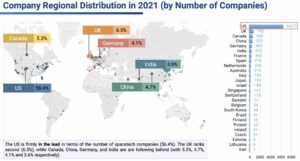The media made the Space Force a joke.
“Basically, no one can believe that this is a real thing and we can hardly blame them.” –The Wrap
“Thankfully, however, the real-life version of the U.S.’s fictional space-faring Military Force, dubbed the Space Force, is already shaping up as one of the best comedy properties of recent times.” –GQ
“Will the incoming [Biden] administration put an end to this unnecessary exercise that Trump admits started as an offhand joke?” –MSNBC
To answer that last question, quoted from the embarrassingly-bias media: No. Instead of shutting down the Space Force, Biden is actually increasing its funding.
 Credit: Kayla White – U.S. Air Force
Credit: Kayla White – U.S. Air Force
President Biden’s 2023 defense budget request has allocated more than $24 billion to the Space Force. That’s almost a 40% increase in spending proposals compared to 2022.
According to Space News, the budget breakdown looks like this:
- $3.6 billion for procurement of satellites and launch services
- $4 billion for operations and maintenance (this includes 4.6% pay raise for civilian personnel)
- $15.8 billion for research development and testing
- $1 billion for personnel costs for 8,600 active-duty guardians
The budget includes plans for satellites that “will be deployed in low Earth orbit to detect and track Russian and Chinese hypersonic missiles.” Air Force Secretary Frank Kendall said the proposed budget was “driven by the threat,” which shows how serious the Space Force has gotten almost overnight.
So what does the Space Force have to do with investing and building businesses?
In 2017 I wrote about how there is an enormous amount of money to be made by being a War Dog Investor. Although it’s been almost five years since I published that piece, it’s worth a read again.
In the article, I show you exactly how you can land enormous government contracts (some worth hundreds of millions of dollars), and how the military industrial complex works.
The more supplies that the government consumes, the more they pay to private bidders, and in theory, the more the economy gets a boost.
So what happens when the government slows down? What happens when there is no war to consume products and services?
Well, we could say there is a conspiracy to start wars to fuel economies… but that would never happen, right?
Sounds a little eerie considering today’s global situation… we’ll just sweep that topic under the rug for now.
The Space Force is about to go on a spending spree.
The Space Force will be handing out contracts and acquiring technology like they have a money printing machine… because they do (it’s called the government and central bank working in tandem).
For entrepreneurs and investors positioned in the space industry, there will be tremendous profit opportunities. That’s because the US has just gotten a wake up call from threats rising out of Russia and China.
One specific threat to the US is the use of hypersonic weapons by both China and Russia. These weapons have the capability of hitting targets literally on the other side of the world. At the same time, these weapons are nearly undetectable and indefensible by current western military technology.
- On July 27th, 2021, “China has tested a nuclear-capable hypersonic glide vehicle, carried on a rocket, that flew through low-orbit space and circled the globe before striking within two dozen miles of its target.” –ACA
- Russia has claimed to have used the first hypersonic missile in combat, which the US has confirmed, in Ukraine. –Defense One
 Science.org has a great infographic that explains the capabilities of hypersonic missiles compared to traditional jets and intercontinental ballistic missiles (ICBMs). Source: Science.org
Science.org has a great infographic that explains the capabilities of hypersonic missiles compared to traditional jets and intercontinental ballistic missiles (ICBMs). Source: Science.org
Currently, the U.S., Russia, China, and North Korea are known to have hypersonic weapons capabilities. But it’s highly likely that all of these countries (and maybe several more) have technologies that have not been disclosed.
Just last month, the Pentagon hosted a hypersonic weapons meeting to keep “pace with China and Russia.” The details of the meeting were not made public, but it was clear that hypersonic experts are concerned with the technology that potential adversaries already possess.
What potential Space Force technology can we invest in?
If you want to take the easy route, you can invest in the top five defense contractors in the world. These companies are all US based, have at least 50% of their revenue from defense contracts, and are all publicly traded.
While it’s true that none of these companies are exclusively focused on space-related technologies, it’s likely that they’ll all see a lot of business in the coming years.
 Source: Defense News
Source: Defense News
If you’re like me and you prefer to invest in early stage private companies, I have a very interesting company to share with you…
But first, I need to tell you a quick story about how GPS signals have been getting jammed on the border of Finland and Russia.
The issue has been reported repeatedly for the past month, with a Lithuania airline having to cancel over a dozen flights.
“The interference began soon after Finland’s President Sauli Niinisto met U.S. counterpart Joe Biden in Washington on Saturday to discuss deepening defence ties between Finland and NATO due to Russia’s attack on Ukraine.” –Reuters
Meanwhile, in Ukraine, there has been a variety of electronic warfare (EW) operations. Ukraine has been able to “recruit a small army of hackers to try and disrupt Russian corporations, banks, and government agencies. Now they are going after Russia’s GPS system called the Global Navigation Satellite System (GLONASS).”
At the same time, Russia is also deploying some of their EW tools. But according to a US official, “We have not seen what we believe [are] the full scope of their electronic warfare capabilities brought to bear. Cannot give you an assessment of why that would be. But we do know and we do have indications that in some places they have used EW to their advantage, particular in jamming, at a local level.”
As you can see, the types of technologies we can invest in are far from traditional warfare weapons. The next generation of war will be electronic, and that’s where many new tech solutions need to be built.
Private US startups will fuel the Space Force.

Source: Spacetech Analytics
Over 50% of the world’s spacetech companies are located in the US. While it’s uncertain if the US will be able to hold on to that market share, it’s highly likely that new spacetech companies will continue to sprout up around the world.
For now, the US is the undisputed market for spacetech companies to grow and to receive investment. There are already dozens of publicly traded space companies and thousands of private startups.
One of those private companies is Xairos – a global timing service that aims to replace timing from GPS. Using their proprietary quantum technology, the company aims to disrupt the outdated and vulnerable GPS system that has been in use since early 1970’s.
“Our timing system is orders of magnitude more accurate and infinitely more secure than timing from GPS. This allows you to know your position to the width of a human hair, and networks to move more data and faster.”
-Xairos
Xairos was founded in 2019, has a very strong folding team, and is already generating revenue. Even more interesting is that you can invest in the company right now, even if you are not an accredited investor.
Please note that I did in fact meet with the CEO of Xairos and I will be investing in this company. However, I did not and will not receive any compensation for sharing this investment. I have zero affiliation with Xairos and I have not invested previously. I think that this company and its technology have a real possibility of being acquired by a major company or by a government entity. I will be investing in this company through the Spaced Ventures portal, HERE.
What’s next for the Space Force?
Last week, the Space Force published a press release addressing the budget proposal for 2023. The release specifically mentioned increased spending for space related technology:
“Among the more notable Space Force line-items are the transfer of the Space Development Agency and budget into the Space Force, $987 million to space technology development and prototyping missile warning/tracking, and $1 billion for ground and space segments of the Next-Generation Overhead Persistent Infrared missile warning system.”
I’ll be keeping an eye on this industry and sharing any future opportunities which I think are interesting.




